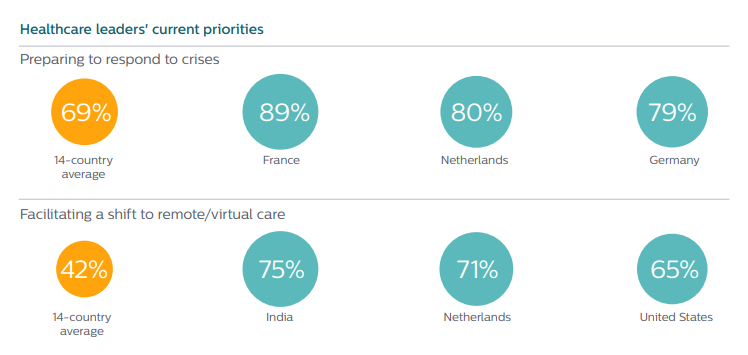Subtotal $0.00

- To ensure social distancing and avoid infection, healthcare practices in many countries shifted from in-person consultations to telemedicine.
- Nearly two-thirds of healthcare providers across 14 global markets are now investing heavily in digital health.
- In developing countries, digital healthcare is also helping, with remote access to specialists.
Senior healthcare leaders from 14 countries say strengthening resilience and preparing for future crises is a top priority, according to a new report commissioned by Royal Philips.
The pandemic has seen many countries shift from in-person medical consultations to telemedicine, using apps, phone and video appointments. Industry analyst IDC predicts that by 2023 nearly two-thirds of patients will have accessed healthcare via a digital front end.
Taking telemedicine beyond the pandemic
Improving resilience and planning for future crises is the top priority for more than two-thirds of senior healthcare leaders surveyed, with France, the Netherlands and Germany scoring the highest. Second in line is the continued shift to remote and virtual care (42%), led by India, the Netherlands and the US.
 The top priorities are preparing to respond to crises and facilitating a shift to remote/virtual care. Image: Royal Philips, 2021
The top priorities are preparing to respond to crises and facilitating a shift to remote/virtual care. Image: Royal Philips, 2021
Accordingly, 64% of healthcare leaders are investing heavily in digital health technology at the moment, but the number drops to 40% when they were asked about their investment levels in three years’ time. This may be because respondents expect solid foundations to have been laid by then or due to continued uncertainty about healthcare funding beyond the pandemic.

A major focus for future health technology investments is the deployment of Artificial Intelligence (AI) and machine learning.
At present 19% of healthcare leaders polled by Royal Philips said they are prioritizing investments in AI but 37% said they plan to do so over the next three years. The aim is to have AI help with clinical decision-making and to predict clinical outcomes.
This ties in with a growing shift from volume-based care targets to value-based care, where predicting patient outcomes will play a key role.
In value-based healthcare models, providers get paid for improving health outcomes rather than for the volume of patients treated. The focus is on treating illnesses and injuries more quickly and avoiding chronic conditions such as diabetes or high blood pressure. The results are better health outcomes and lower costs for both the healthcare system and the patient, thanks to fewer doctor’s visits, tests, interventions and prescriptions.
IDC has forecast that by 2026 two-thirds of medical imaging processes will use AI to detect diseases and guide treatment. A growing number of healthcare leaders believe that investing in AI technology is important for the future of their medical facility, according to the Royal Philips report.

What is the World Economic Forum doing about healthcare value and spending?
Each year, $3.2 trillion is spent on global healthcare making little or no impact on good health outcomes.
This council partners with governments, leading companies, academia, and experts from around the world to co-design and pilot innovative new approaches to person-centered healthcare.
Overcoming barriers to digital health
While healthcare leaders are clearly aware of the value of their digital investments, there are still many barriers to the sector’s digital transformation.
A lack of technology experience among staff is one major obstacle, highlighting the need for more digital training for those at the front line of healthcare provision. At the same time, governance, interoperability and data security challenges need to be overcome.
Resolving those will not be easy – which is why 41% of respondents highlighted the importance of forming strategic partnerships with technology companies or other healthcare facilities to jointly roll out new digital technology.
The formation of technology-enabled ecosystems is expected to contribute to offloading around a quarter of routine care from hospitals. Over the next three years, across the 14 markets surveyed, healthcare services at walk-in clinics and in-patient treatment centres will grow by around 10% each, pharmacies by 4% and home care by 6% on average.

This trend is stronger in countries where healthcare provision is more likely to be in a rural setting, such as India and China.
This may be because digital technology has the potential to bridge healthcare gaps in underserved rural communities, especially in emerging markets. For example, an all-female health provider in Pakistan, Sehat Kahani, has e-health clinics around the country where – for a cost of $0.66 – patients can see one of a network of 1,500 doctors via a digital platform.
Discover
What is the World Economic Forum doing about healthcare data privacy?
The Healthcare Data Project at the World Economic Forum Centre for the Fourth Industrial Revolution Japan grapples with the question of how societies should balance the interests of individual citizens, businesses and the public at large when it comes to sensitive healthcare issues. An improved approach to governance during a number of health crises, including pandemics, can help build trust and possibly even save lives.
Additionally, a recent white paper examining existing data-governance models, discovering that most are biased toward the interests of one of three major stakeholder groups. The whitepaper revealed the need for a balanced governance model designed to maximize the socially beneficial potential of data while protecting individual rights such as privacy and the legitimate interests of data holders.





